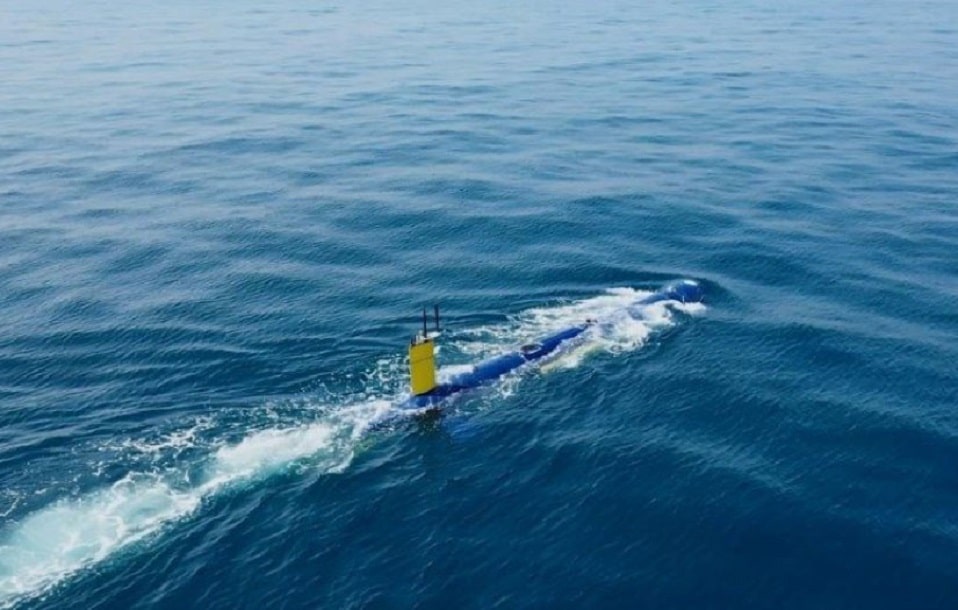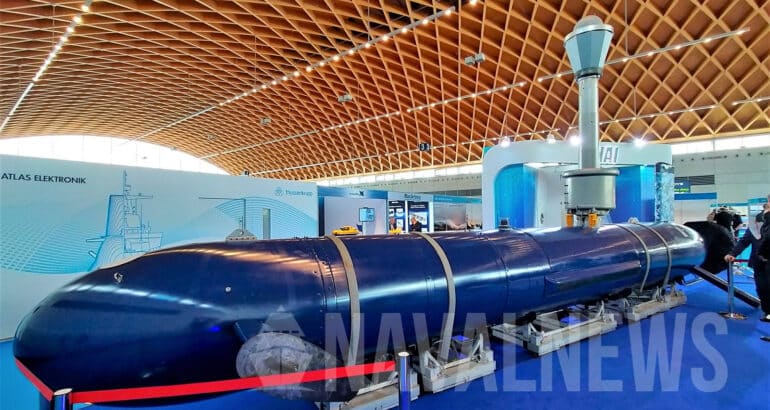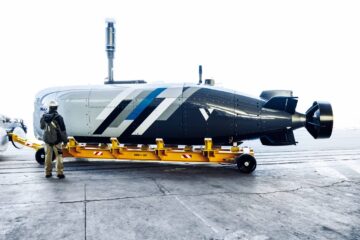At the IAI booth during UDT 2023, guests were welcomed with a set of Virtual Reality (VR) goggles that immersed them in the underwater environment of the BlueWhale System, an autonomous submarine system designed to carry out Anti-Submarine Warfare (ASW), Mine CounterMeasure (MCM) and Intelligence, Surveillance and Reconnaissance (ISR) missions.
The BlueWhale, 10.9m in length and 1.12m in diameter, weighs 5.5 tons and is capable of operating up to 300m depths. It features an AESA radar, Electro-Optical/Infra-Red cameras, sonars, magnetic sensors and SATCOM communications to facilitate the multiple missions it has been designed to carry out.
“The advantage of the full suite is to be able to provide a full situational awareness picture when conducting an ISR mission for example,” Michael Sela, Ret. CDR in the Israeli Navy and currently Business Development and Marketing Manager at IAI, told Naval News. This means that while the AESA radar is detecting all naval tracks on the water surface, the BlueWhale can also leverage the EO/IR sensors and the geolocation capabilities to detect and give the precise location of all potential threats and targets onshore. “So if I am using the BlueWhale to prepare for a special forces landing mission, for instance, the system can send all the information needed via SATCOM to prepare the mission,” Sela added.
For ASW missions the BlueWhale works in bi-static mode. A surface platform acts as the pinger while the autonomous submarine system, which carries a Atlas Electronik’s advanced tripled Towed Array Sonar (TAS), functions as the passive receiver. When asked if a submarine could potentially detect the BlueWhale, Sela told Naval News:
“It is almost impossible, the submarine would have to have specific intelligence that such systems are active in the area and would have to be actively looking for it.”
Michael Sela, Business Development and Marketing Manager at IAI
Just as importantly, the BlueWhale is made with aluminium and composite material, giving no magnetic signature.
All processing is done on the BlueWhale computer, hosted in the pressure hull. The computer features Artificial Intelligence (AI) algorithms that will process, analyse and transfer information according to mission specifications. This can be geolocation, videos, or simply small packets of information, depending on the needs. “And of course, all information remains available for post-mission analysis,” Sela added.
The BlueWhale is powered by lithium ion batteries, hosted in the pressure hull of the BlueWhale. “Depending on the type of mission being carried out, these batteries provide between 10 and 30 days of full autonomy,” Sela commented. Systems like the towed array can, in fact, be quite demanding on battery power. Currently, charging has to be done onboard a mother ship or onshore.
“Today we have designed the BlueWhale to respond to a wide range of requirements for three different missions, however IAI remains open to discussions with customers to continue improving its functionalities, such as autonomous charging”
Michael Sela, Business Development and Marketing Manager at IAI
About BlueWhale

IAI unveiled its BlueWhale just ahead of UDT 2023. This XLUUV is designed for high-endurance and stealthy intelligence gathering, anti-submarine warfare (ASW), mine countermeasures (MCM), and other critical missions operating in open seas, hard-to-access littoral waters and choke points.
BlueWhale can detect and track targets, both above and below surface, and perform onboard sensor data processing. Actionable intelligence is relayed in real-time to the command and control over a dedicated broadband-secured satellite channel.
BlueWhale can perform a multitude of missions:
- Bi-static submarine detection with Towed Array Sonar (TAS)
- Acoustic passive intelligence gathering with flank and towed arrays sonars
- Covert mine detection and other Mine Counter Measures (MCM)
- Covert surface & subsurface Littoral ISR (Intelligence, Surveillance and Reconnaissance)
- Submarine forward scout
- Special Force support – Forward Scout & Mule
- Submarine forward scout
- Special Force support – Forward Scout & Mule
| Technical Details | Performance |
| Length / Diameter | 10.9 / 1.12 meters |
| Weight | 5.5 tons |
| Endurance | (dependent 30 Days (Mission & Battery supply – 10 |
| Speed | Operational: 2-3 knots / max. 7 knots (Submerged) |
| Payload Sensors and Communications Options | RADAR, EO/IR, SIGINT, sonars, magnetic sensors and SATCOM |






